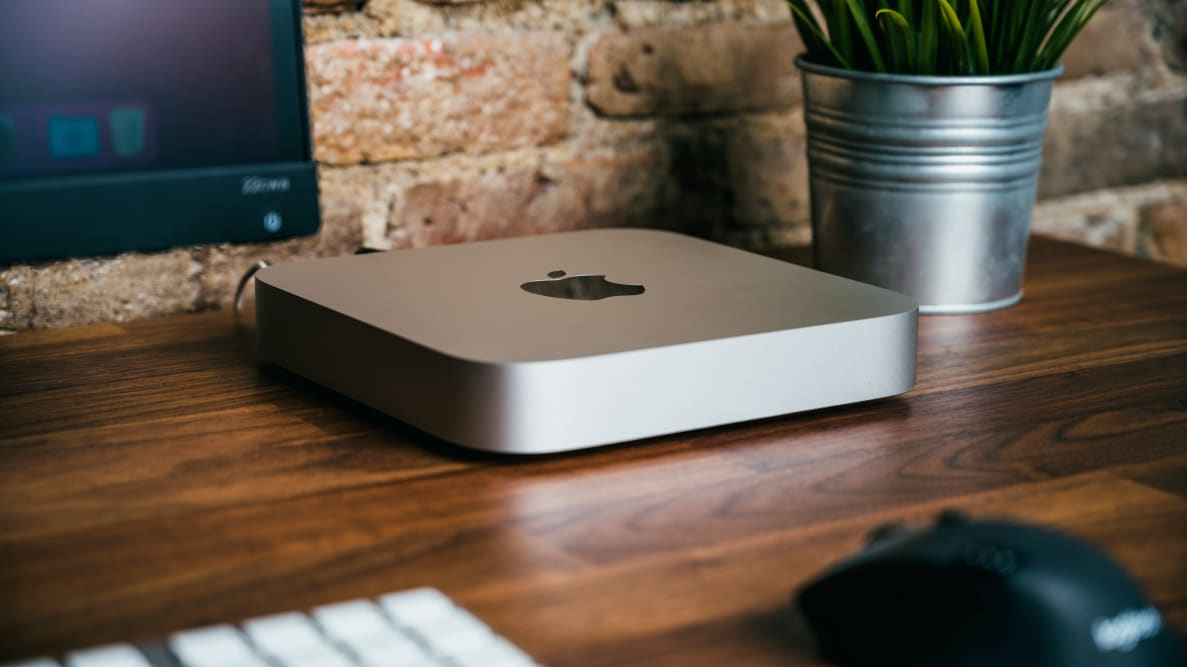Pros
-
Powerful M1 processor
-
Efficient cooling and power
-
Compact, space-saving design
Cons
-
Doesn’t include a monitor or peripherals
Compared to other $700 mini-PCs, the M1 Mac Mini offers good value. We wish it came with the ability to upgrade its memory or storage down the line, but its performance for the price is phenomenal. If you don’t need a laptop, you may want to take a good look at this Mac over the other new MacBooks.
The M1 Mac Mini has fewer ports than its predecessor, with only 2 USB-C and 2 USB-A connectors that will leave those with many peripherals drowning in dongles and hubs. If you need a desktop with desktop-like features and desktop-like performance, you’ll have to spend more on a tower PC, but for the price and size you can't beat the Mac Mini.
Finally, no matter how spectacular the new M1 Macs are, we have to pause to remember these are brand new processors. Many mainstream apps, such as Chrome, World of Warcraft, and Photoshop already have M1 support, but there are just as many that are lagging behind and emulating at a sluggish pace on the M1 (looking at you, Steam). If you depend on applications from smaller developers, you may want to wait a while to let developers have time to add support for the M1 processors so that you can have a smoother experience.
About the Late 2020 M1 Mac Mini
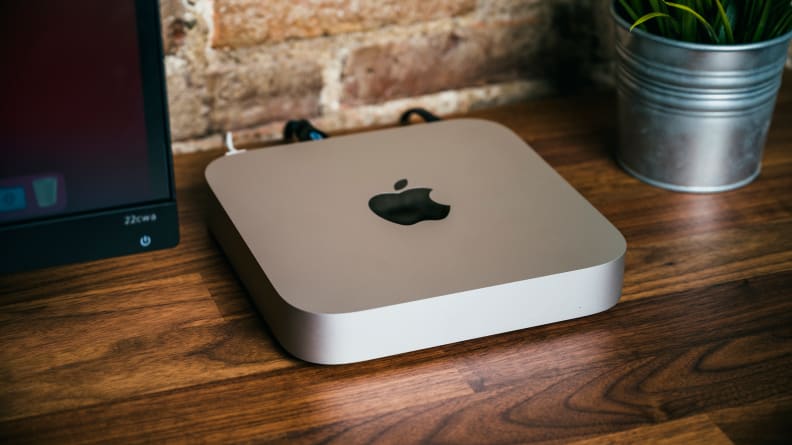
Although the M1 Mac Mini is only $700, it savagely outperforms the $1,000 Intel Mac Mini.
The Mac Mini fills a surprisingly popular niche: it’s a desktop with laptop-grade performance for folks who need a simple, reliable office machine. It’s cheap, it’s small, and it’s intuitive. It’s also more powerful than most laptops you’d get at its $700 price point, and you can move it around the house (or world) with relative ease.
This new Mac Mini has the exact same processor as the new MacBook Air and MacBook Pro: the Apple Silicon M1 processor, a powerful ARM processor that has pushed the limits of what Apple can do with regards to both performance and power efficiency. The Mac Mini doesn’t have (or need) a 20-hour battery to show off, but it can claim insanely low power consumption and ultra-cool thermals as a result of this new mobile processor’s efficiency.
We wanted to experience the M1’s worst-case scenario, so we just tested the base model. Here are the notable specs: * Processor: Apple M1 8-Core Processor * Memory: 8 GB RAM (16 GB RAM upgrade also available) * Storage: 256 GB RAM (512 GB, 1 TB, 2 TB also available) * Display: HDMI 2.0 HDR output; USB-4 output; supports up to 2 displays * Ports: 2 x Thunderbolt 3; 2 x USB-A 3.1 Gen 2; Gigabit Ethernet; 3.5mm headphone jack; HDMI 2.0 * Graphics: 8-Core Integrated GPU * Connectivity: WiFi 6; Bluetooth 5.0; 10 Gigabit Ethernet * Max Continuous Power: 150 Watts * Weight: 2.6 lbs * Dimensions: 1.4” x 7.7” x 7.7” * Warranty: 90 days complimentary technical support and a one-year warranty
What We Like
The M1 Silicon’s punch does not disappoint
When we first saw the Apple keynote in early November, we were skeptical of the grandiose claims Apple made about the new M1 processor. Apple promised us that it would provide 18-hours of battery life on MacBooks, that it would always stay cool, and that it would crush every mobile processor on the market. Thankfully, Apple has delivered on these promises.
I’ve been alternating between a decked out mid-2020 MacBook Pro and a couple of custom-built PCs as my main machines. I wouldn’t say the new Mac Mini is a better performer than my desktop PCs, but it wipes the floor with my 6-month-old MacBook Pro. The Mac Mini broke almost all of our benchmark records; it broke our Geekbench 5 multicore high by over 1,000 points, scoring a total of 7,667 points. Similarly, it crushed our web tests and other CPU tests, proving to be the best laptop-grade CPU we’ve ever tested.
When it comes to gaming and GPU performance, it outperforms Intel’s and AMD’s latest CPU graphics, but the difference there isn’t as extreme as it is with general tasks. Likewise, if you’re looking for a gaming computer, a discrete Nvidia or AMD GPU still notably outperforms the M1’s graphics processor.
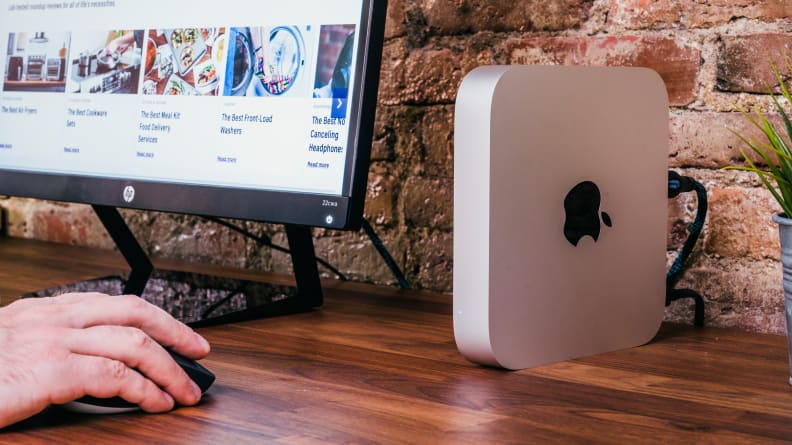
For the everyday person, the Mac Mini is the perfect computer.
But more casual gamers will be more than pleased with what they find on the Mac Mini. We were able to pull a steady 21 frames per second on Shadow of the Tomb Raider with all the graphics settings cranked up at 1080p—my 10th gen Intel Core i7 MacBook Pro managed just 7 frames per second. If you turn the graphics settings down to medium, the game runs at a cool 60 frames per second.
Meanwhile, the Mac Mini doesn’t break a sweat on less intense games, like World of Warcraft, where we were able to get a solid 60 frames per second in 4K resolution without turning our graphics settings too low.
Where the M1 really shines is in web performance. Here, the processor feels ridiculously snappy, with windows loading instantly and scripts running smoothly. I didn’t spot a noticeable speed upgrade between the Mac Mini and the Intel MacBook Pro, but the benchmarks don’t lie: the Mac Mini significantly outdid the MacBook Pro in its capacity to handle web-based scripts. I wouldn’t be surprised if the Mac Mini still feels snappy in 5 years, whereas I can’t say the same of my MacBook Pro.
The M1 has more than enough power for almost anyone’s needs, including those of the occasional video editor. When we tested it with small nonlinear video files, buffering times were minimal, although the M1 did have trouble with running any apps that hadn’t yet ported over to native M1 support.
The new M1 processor can run iOS and iPadOS apps, too
For those glued to your iPhone or iPad because of its amazing app store, fret no more—you can now run these apps natively on the Mac Mini. For these new processors, Apple used the same architecture it used for its phone and tablet processors. However, because the Mac Mini does not have a touchscreen, you will have to get used to the wonky UI of mobile touchscreen apps on the computer, so this native support ends up being most useful for apps already planned with MacOS compatibility in mind.
The Mac Mini is as powerful as the MacBook Pro… for much less money
One of the Mac Mini’s greatest shortcomings until now was its modest hardware. With this late 2020 model, Apple has decided to include the same processor in the Mac Mini as the MacBook Air and Pro. You may not have get a keyboard and display with the Mac Mini, but you do get to save up to $500 in comparison to the new MacBooks. Is the Mac Mini more powerful than most desktops in its price range? Not really, but it’s certainly more powerful than any other sub-$800 desktop that’s less than a cubic foot in size, and it's loads more powerful than the previous Intel Mac Mini (which is selling for a higher retail price than the M1 Mac Mini!). Apple hasn’t made a product with this kind of value in a very long time.
What We Don’t Like
The port availability and wireless connectivity on the Mac Mini is abysmal
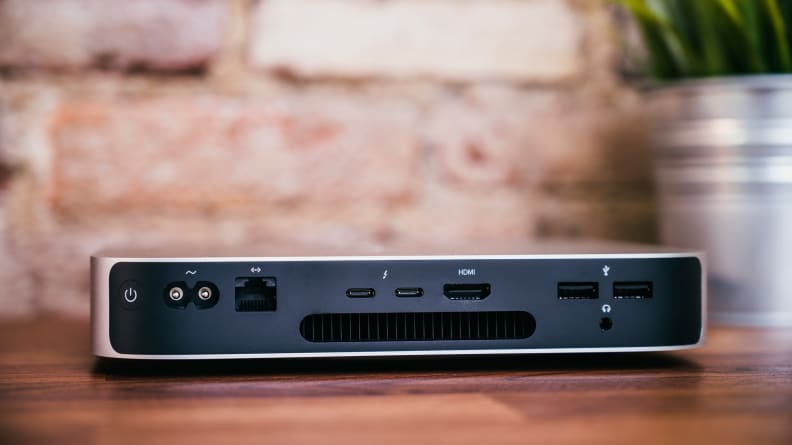
The Mac Mini would have benefited from a few additional ports, such as an extra Displayport or several more USB-A connectors to mitigate the need for USB hubs.
On this desktop PC, you will have access to two Thunderbolt 3 ports, two USB-3 Type-A ports, one HDMI 2 port, one headphone jack, and one Ethernet port. On a laptop, this would have been a solid I/O layout, but for a desktop it feels paltry. By comparison the late Intel Mac Mini has two more Thunderbolt ports, bringing it up to a total of 4 ports and support for up to three displays (the M1 version only supports two displays).
If you plan to plug in anything but a keyboard, mouse, and a monitor, you will almost certainly need a USB hub to connect all your peripherals (for example: a printer, a second display, a microphone, or a streaming card).
One of the perks of the Mac Mini is that it does come with an Ethernet port, so you can plug in for the fastest connection possible. Its WiFi is similarly responsive, thanks to its WiFi 6 chip. Where connectivity falls short is on Bluetooth: many Mac Mini and M1 MacBook users have been reporting problems connecting their Bluetooth peripherals. In some cases, the connection drops out and leaves the user without a mouse, keyboard, or headphones. I didn’t have any issues accessing Bluetooth devices with my Mac Mini unit, but this is something to keep in mind so you can always have a backup wired mouse and keyboard.
You can’t upgrade
Another step backward for the Mac Mini is its upgradeability. On the previous model, you can add memory or storage to the inside of the computer. With the M1 model, the chassis has the physical space for an extra memory stick or another SSD, but there is no way to connect them to the rest of the hardware.
Apple decided to solder the memory and storage directly onto the M1 in order to have a more direct connection between the modules and the CPU, resulting in an overall faster computer with less power-hungry hardware. However, this also means you’re stuck with whatever you bought on day one. For many, this won’t be a problem, but that does mean we would advise getting the upgraded 16 GB RAM model with at least 500 GB of SSD space if you don’t want to feel too constricted within a year or two.
This also means that those hoping for a Mac Mini with 32GB of memory will have to wait to see what the iMac and the Mac Pro have to offer for their next cycles. Otherwise, you’ll have to stick with an older Mac or a Windows/Linux PC if you want to have more hardware upgradeability.
The Mac Mini speakers sound like they’re coming from a tinny garbage can
Of all the perks and flaws I would have expected from the Mac Mini, this one threw me off guard. Most Apple computers have excellent speakers, but the M1 Mac Mini’s speakers are a notable exception. I’ve heard better speakers on $300 Chromebooks.
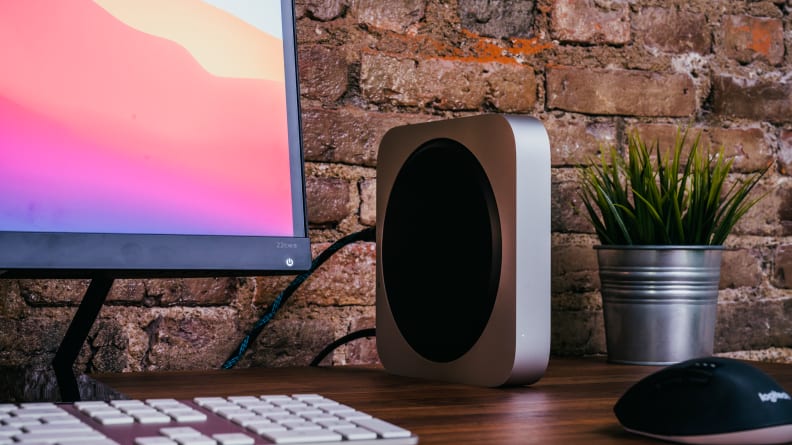
The Mac Mini's speakers are some of the worst audio playback devices that Apple's ever released.
That said, I can understand why Apple didn’t pay much attention to the Mac Mini’s speakers. Because it’s a desktop, Apple may have assumed most users would be plugging the Mac Mini into an external audio system of their choosing—especially if the Mac Mini is used as a living room or home theater PC.
However, I don’t like that assumption. It shows sloppiness on Apple’s part, as if the Mac Mini were an afterthought in the M1 launch lineup. This is supposed to be Apple’s most affordable PC offering, but it’s still not cheap at $699. Mac Mini owners deserve better, especially given how excited its fans were about this refresh to the tiny PC’s lineage.
The M1 chip is still too new for most developers
While the M1 processor runs beautifully when used for native apps, its performance does suffer when it needs to run an app through Rosetta, Apple’s x86 architecture emulation program. Basically, most PC apps these days run on x86 architecture, which is native to both Intel and AMD processors. Apple’s switch to the M1 processor is a huge deal because it turns away from x86 architecture in favor of ARM architecture, which is what Apple has been using in its mobile processors for years.
Apple knew that this incompatibility could be a problem, so the company built Rosetta, an emulator that can run all the apps that are designed for Intel and AMD processors. Apple admittedly made it very easy to install and run—the computer will ask you to automatically download Rosetta when you try to launch an x86 app for the first time. This means you can theoretically run any of your old favorite apps, but the reality is a bit different.
One major app that’s been having trouble is Steam. I don’t have a problem running Steam on my Intel-based MacBook Pro. However, Steam runs with lots of lag and stuttering on the Mac Mini because it needs to be emulated through Rosetta. Similarly, most of my Intel Mac-compatible games suffered a performance hit from the emulation, and some refused to run at all.
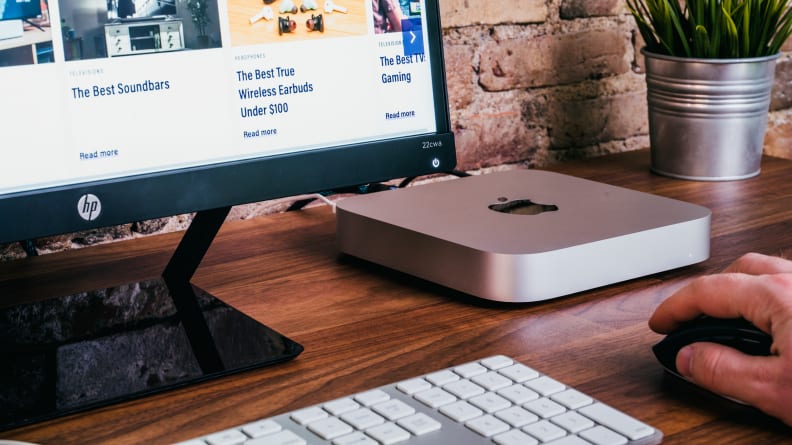
While the M1 processor is incredibly capable for everyday tasks and for content creation, it still has a way to go with regards to compatibility with more applications.
It’s important to note that this “problem” will resolve itself over time as developers finalize builds designed for the M1 processors. Many major developers, such as Adobe, Google, and Microsoft have already either pushed out M1 versions of their software or are currently working on future M1 versions. This issue is most likely to affect those who rely on software from smaller developers who may not have the resources to work on M1 versions of their MacOS builds, and so those programs could be abandoned on Mac in the near future.
Should you buy it?
Absolutely—provided you don't have a need for many peripherals or niche programs.
The new M1 Mac Mini is undoubtedly one of the best products Apple has released in a long time. Compared to the late Intel Mac Mini, the M1 version is a standout. For $700, $300 less than the Intel version, the M1 model offers a much more powerful 8-core processor that will need less power to run. This is an exceptionally fast, virtually silent, tiny desktop that is perfect for daily office work, web browsing, and even video editing (given that the software is available for M1 Macs). If you’re someone who almost always uses mainstream software, or you’re someone who’s been with the Apple ecosystem for a long time, then you’ll no doubt love the new Mac Mini.
On the flip side, while the M1 is a great step forward for Apple, there are many little things about the new Mac Mini that feel like a downgrade from the last Intel-based one. Compared to the Intel model, the M1 model has fewer ports, no memory or storage upgradeability, and awful speakers. This makes the Mac Mini restrictive for power users who need access to many peripherals or lots of memory and total computational power, even if the M1 8-core processor itself is technically very capable.
Serious Mac creators should wait a bit for new iMac and Mac Pro announcements if they want to switch over to Apple Silicon processors (Bloomberg sources report that these models could have up to 32 cores in their processors, whereas the Mac Mini comes with 8 cores), and gamers should once again stick to gaming PCs. For literally everyone else (and for those aforementioned people when they’re not playing Microsoft Flight Simulator or modeling in Maya), the Mac Mini is an incredibly capable machine that offers a fantastic user experience for everyday enjoyment.
Meet the tester
Adrien has over 4 years of experience covering laptops, desktops, software, games, and more.
Checking our work.
Our team is here to help you buy the best stuff and love what you own. Our writers, editors, and experts obsess over the products we cover to make sure you're confident and satisfied. Have a different opinion about something we recommend? Email us and we'll compare notes.
Shoot us an email
